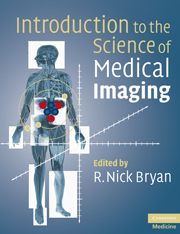Book contents
- Frontmatter
- Contents
- List of contributors
- Introduction
- Section 1 Image essentials
- Section 2 Biomedical images: signals to pictures
- Section 3 Image analysis
- 11 Human observers
- 12 Digital image processing: an overview
- 13 Registration and atlas building
- 14 Statistical atlases
- Section 4 Biomedical applications
- Appendices
- Index
- References
12 - Digital image processing: an overview
Published online by Cambridge University Press: 01 March 2011
- Frontmatter
- Contents
- List of contributors
- Introduction
- Section 1 Image essentials
- Section 2 Biomedical images: signals to pictures
- Section 3 Image analysis
- 11 Human observers
- 12 Digital image processing: an overview
- 13 Registration and atlas building
- 14 Statistical atlases
- Section 4 Biomedical applications
- Appendices
- Index
- References
Summary
Characteristics of digital image data
Images produced by most of the current biomedical imaging systems, right from the signal capture and transduction level, are digital in nature. The main purpose of processing such images is to produce qualitative and quantitative information about an object/object system under study by using a digital computer, given multiple, multimodality biomedical images pertaining to the object system under study. As described in other chapters, currently many imaging modalities are available that capture morphological (anatomical), physiological, and molecular information about the object system being studied. The types of objects studied may include rigid (e.g., bones), deformable (e.g., soft-tissue structures), static (e.g., skull), dynamic (e.g., lungs, heart, joints), and conceptual (e.g., activity regions in PET and functional MRI, isodose surfaces in radiation therapy) objects.
Currently, two- and three-dimensional (2D and 3D) images are ubiquitous in biomedicine, e.g., a digital or digitized radiograph (2D), and a volume of tomographic slices of a static object (3D). Four-dimensional (4D) images are also becoming available which may be thought of as comprising sequences of 3D images representing a dynamic object system, e.g., a sequence of 3D CT images of the thorax representing a sufficient number of time points of the cardiac cycle. In most applications, the object system of study consists of several static objects. For example, an MRI 3D study of a patient's head may focus on three 3D objects: white matter, gray matter, and cerebrospinal fluid (CSF).
Information
- Type
- Chapter
- Information
- Introduction to the Science of Medical Imaging , pp. 214 - 229Publisher: Cambridge University PressPrint publication year: 2009
